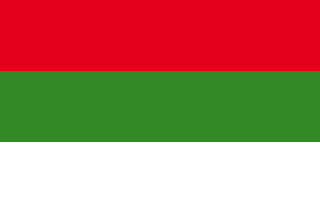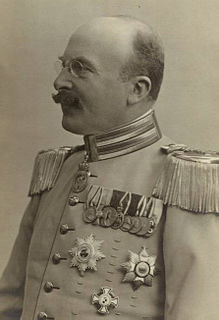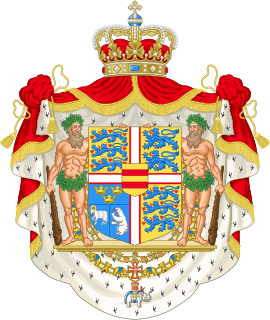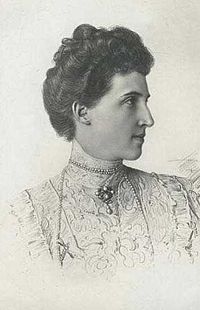

- Friedrich, Hereditary Prince of Anhalt (1938-1963)
- Eduard, Prince of Anhalt (born 1941)
- (1) Princess Julia Katharina (born 1980)
- (2) Julius Maxime Laszlo (born 2010)
- (3) Princess Julia Eilika (born 1985)
- (4) Leopold (born 2011)
- (5) Julia Philine (born 2013)
- (6) Princess Julia Felicitas (born 1993)
- (1) Princess Julia Katharina (born 1980)
Line of succession in November 1918




- (1) Prince Eugen Frederick (born 1903)
- (2) Prince Wolfgang (born 1912)
- (3) Prince Aribert Joseph (born 1866)
Related Research Articles

The Duchy of Anhalt was a historical German duchy. The duchy was located between the Harz Mountains in the west and the river Elbe and beyond to the Fläming Heath in the east. The territory was once ruled by the House of Ascania, and is now part of the federal state of Saxony-Anhalt.

Frederick VII was King of Denmark from 1848 to 1863. He was the last Danish monarch of the older Royal branch of the House of Oldenburg and also the last king of Denmark to rule as an absolute monarch. During his reign, he signed a constitution that established a Danish parliament and made the country a constitutional monarchy. Frederick's motto was Folkets Kærlighed, min Styrke .
An heir presumptive is the person entitled to inherit a throne, peerage, or other hereditary honour, but whose position can be displaced by the birth of an heir apparent or of a new heir presumptive with a better claim to the position in question.

Leopold succeeded in 1830 as the Grand Duke of Baden, reigning until his death in 1852.

The Order of the Black Eagle was the highest order of chivalry in the Kingdom of Prussia. The order was founded on 17 January 1701 by Elector Friedrich III of Brandenburg. In his Dutch exile after World War I, deposed Emperor Wilhelm II continued to award the order to his family. He made his second wife, Princess Hermine Reuss of Greiz, a Lady in the Order of the Black Eagle.
The German Empire and Kingdom of Prussia were abolished in 1918. The current head of the former ruling House of Hohenzollern is Georg Friedrich, Prince of Prussia. The Law of Succession used is Agnatic Primogeniture.

Prince Aribert Joseph Alexander of Anhalt was regent of Anhalt from September to November 1918 on behalf of his underage nephew, Duke Joachim Ernst. As regent, following the German revolution, he abdicated in the name of his nephew on 12 November 1918, thus ending the rule of the House of Ascania in Anhalt.
The monarchy in Baden came to an end in 1918 along with the rest of the monarchies that made up the German Empire. The last sovereign was Grand Duke Frederick II who abdicated at Karlsruhe, 14–22 November 1918. The current head of the Grand Ducal House is Maximilian, Margrave of Baden and Duke of Zähringen.
The Electorate of Hesse was abolished in 1866 when it was annexed by the Kingdom of Prussia, while the Grand Duchy of Hesse and by Rhine came to an end in 1918. Like most former German realms of the Holy Roman Empire the succession in Hessian lands was semi-Salic, with the nearest female kinswoman of the last male inheriting the crown upon extinction of the dynasty in the male line. The current pretender to both Hessian thrones is Donatus, Landgrave of Hesse, from the electoral line of the family, which inherited its claim to the grand duchy following the death of Prince Louis of Hesse and by Rhine in 1968. Donatus became head of the House of Hesse on the death of his father, Prince Moritz, in 2013. Landgrave Donatus is the titular Grand Duke and Elector of Hesse.

Julius Eduard Ernst August Erdmann, Prince von Anhalt, usually referred to as Prince Eduard, is the head of the House of Ascania, the family which ruled the Duchy of Anhalt until 1918.

Joachim Ernst, Duke of Anhalt was the last ruler of the Duchy of Anhalt.
Leopold Friedrich Franz Sieghard Hubertus Erdmann, Hereditary Prince of Anhalt was the head of the House of Ascania, the family which ruled the Duchy of Anhalt until 1918.

Eduard Georg Wilhelm, Duke of Anhalt was a German prince of the House of Ascania and the penultimate ruler of the Duchy of Anhalt from April to September 1918.

Princess Marie Auguste of Anhalt was the daughter of Eduard, Duke of Anhalt, and his wife, Princess Louise Charlotte of Saxe-Altenburg. She married and divorced a son of Kaiser Wilhelm II, then married and divorced a baron.

The Monarchy of Denmark, colloquially known as the Danish Monarchy, is a constitutional institution and a historic office of the Kingdom of Denmark. The Kingdom includes Denmark proper, as well as the autonomous countries of the Faroe Islands and Greenland. The Kingdom of Denmark was already consolidated in the 8th century, whose rulers are consistently referred to in Frankish sources as "kings". Under the rule of King Gudfred in 803 the Kingdom may have included all the major provinces of medieval Denmark. The current unified Kingdom of Denmark was founded or re-united by the Viking kings Gorm the Old and Harald Bluetooth in the 10th century. Originally an elective monarchy, it became hereditary only in the 17th century during the reign of Frederick III. A decisive transition to a constitutional monarchy occurred in 1849 with the writing of the first Constitution. The current Royal House is a branch of the princely family of Glücksburg, originally from Schleswig-Holstein in modern-day Germany, the same royal house as the Norwegian and former Greek royal families.
Events in the year 1918 in Germany.

Princess Louise Charlotte of Saxe-Altenburg was a German noblewoman. She was a princess of Saxe-Altenburg by birth and a princess of Anhalt by marriage.

Beginning in 1928, some members of higher levels of the German nobility joined the Nazi Party, registered by their title, date of birth, NSDAP Party registration number, and date of joining the Nazi Party, from the registration of their first prince (Ernst) into NSDAP in 1928, until the end of WWII in 1945. Following the Wilhelm II abdication and the German Revolution, all German nobility as a legally defined class was abolished. On promulgation of the Weimar Constitution on 11 September 1919, all such Germans were declared equal before the law. There were 22 heads of these former federal states, titled as the 4 Kings of Germany; Prussia, Bavaria, Saxony, and Württemberg, there were also 6 Grand Dukes, 5 Dukes, and 7 Princes, who along with all of their heirs, successors and families, lost their titles and domains. In appeasement of such losses, Hitler, Goring, Himmler, and other Nazi leaders, frequently appealed to these (former) princes, and especially to Wilhelm II and his families from the former Prussian kingdom, by expressing sympathy for a restoration of their abolished monarchies, and such lost inheritances. In 1928, the newly formed Nazi Party began accepting these princes by their (abolished) former titles, and by their (abolished) princedoms, and registering these dukes, princes, and princesses as such, in NSDAP. There are two know NSDAP – lists of such princes and princedoms. Of the first list Historian Malinowski quotes; of 312 families of the old aristocracy 3,592 princes joined the Nazis (26.9%) before Hitler came to power in 1933. The second Berlin Federal archives list, depicts 270 princely members of the Nazi Party (1928–1942), of which almost half joined the Nazis pre-Hitler. The Berlin list named 90 direct senior heirs, to their 22 abolished princedoms, and also included claimants to the (former) Imperial Crown of Wilhelm II. After the proposed Prussian – "fourth Kaiser" died in the Wehrmacht in 1940, Hitler issued the Prinzenerlass, prohibiting German prices from the Wehrmacht, but not from the Nazi Party, SA or SS. Some German states provided a proportionally higher number of SS officers, including Hesse-Nassau and Lippe. Such German princes included SS–Obergruppenführer and Higher SS and Police Leader Prince Josias of Waldeck and Pyrmont.
References
- ↑ Zoepfl, Heinrich. "Reading Notes on Family Law in German Ruling Families of the 19th Century" . Retrieved 15 May 2017.
- 1 2 Theroff, Paul. "Anhalt" . Retrieved 15 May 2017.
- 1 2 "Aktualisierung des Hausgesetzes der Familie Anhalt-Askanien | Anhalt-Askanien". www.anhalt-askanien.de. Retrieved 15 May 2017.